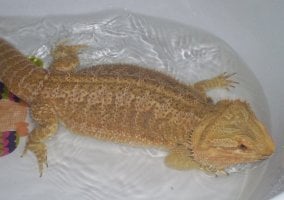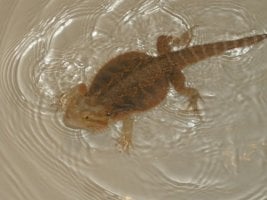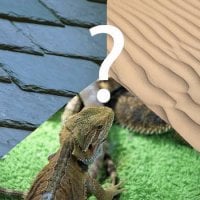Behavior Why is My Bearded Dragon's Beard Black?
- By Shinryu
Is Bearded Dragon Color Change Normal?

How is your bearded dragon's overall behavior--are they lethargic, refusing to eat, or exhibiting signs of illness? Did you recently change something in your beardie's enclosure? Is there a new pet in the house? Did your beardie recently have a stressful or frightening experience? Is your bearded dragon exhibiting classic mating signs, such as doing a head bob or showing any signs of being territorial?
If your bearded dragon's beard stays black for prolonged periods or often recurs, especially when accompanied by other troubling symptoms, this would be more concerning than an occasional, fleeting behavior.
The truth is that bearded dragons' beards turn black for various reasons. Sometimes, we can only take an educated guess by examining the context.
Some of the more common reasons include the following:
In many cases, the actual cause is impossible to identify. As long as the darker color returns to normal, and you aren't seeing it frequently, there is probably no reason to worry.
Wild Magazine reported that darkened skin helps beardies heat their bodies faster, and this ability can help them save up to 22 minutes of basking time per day!
Scientists have observed that bearded dragons can change the color on their backs in response to ambient temperatures. In addition, color changes on the chest and beards were strongly associated with social displays.
Scientists even observed bearded dragons shift colors in relation to their circadian rhythm--being lighter during sleep and darkest in color right before waking up.
Now that we understand the scientific reasons behind the color changes, let's look at common reasons these wonderful pets darken their colors.
Perhaps, you recently got your bearded dragon, who is still getting used to the enclosure. Other signs of general stress could include glass surfing, pacing, stress marks, and clawing at the enclosure/decor.
 Sometimes bearded dragons will show fear by suddenly getting puffed up, and their beards will turn black in response to feeling threatened. Look for other possible indicators of fear or anxiety, such as hissing and flattening the body while tilting it to the side.
Sometimes bearded dragons will show fear by suddenly getting puffed up, and their beards will turn black in response to feeling threatened. Look for other possible indicators of fear or anxiety, such as hissing and flattening the body while tilting it to the side.
Loud noises, other pets, such as cats and dogs, other bearded dragons, being unexpectedly grabbed from above, unexpected movements, seeing or hearing birds, ceiling fans, and many other things can frighten your beardie and cause them to temporarily black beard.
In these cases, the beard will return to normal color shortly after the perceived danger has passed and your beardie has had time to calm down.
Even if your bearded dragon cannot see other beardies, sometimes he will react to his reflection in the glass, assuming it's another male dragon. A good terrarium background can significantly reduce or eliminate this particular source of stress.
If you have more than one bearded dragon and are not planning on breeding them, house them so they cannot see each other during the breeding season.
Bearded dragons can be sensitive to change. Sometimes, even a minor change can cause a temporary black beard. If you haven't changed anything inside the terrarium, consider if you have moved the terrarium to another room, introduced new pets or kids into the household, adjusted the temperature, or altered your beardie's home environment in some other manner.
If the answer is yes, and you aren't seeing any troubling signs of illness or pain, then sometimes all you can do is give it time. Then, as your bearded dragon adapts to the changes, you should see a black beard less frequently.
If your beardie's beard suddenly turns dark, one place to look for clues is the stool/urate. Sick beardies may exhibit signs of diarrhea or dehydration (dry, chalky urate). A dark beard accompanied by vomiting would also be concerning.
Sick lizards tend to be lethargic, could have sunken eyes, and frequently will refuse to eat or drink.
Bearded dragons who are very sick or near death will frequently have a black beard and other troubling symptoms. If your bearded dragon is showing signs of illness in addition to a black beard, please schedule an appointment with your veterinarian as soon as possible.
Chronic illnesses such as MBD (metabolic bone disease) can cause your bearded dragon to experience pain, resulting in bouts of darker color.
Beardies preparing for brumation or waking up after brumation can be cranky, groggy, and lack an appetite. Not unexpectedly, these hormonal changes can lead to temporary color changes. A male dragon could also be gearing up for the mating season after brumation, which could affect his color.
Brumation is a normal and natural process, so if you witness your bearded dragon turning black before or after brumation, give your pet time to adjust while providing supportive care.
The second bearded dragon care practice to review is basking temperatures. Proper basking temperatures are essential for reptiles to digest food properly and regulate their body heat and temperature. If they cannot thermoregulate properly, you may see signs of stress, including color changes.
Review all your husbandry practices if your bearded dragon experiences unexplained bouts of beard darkening. But first, ensuring your beardie has proper UVB and a good heat source is essential.
On our bearded dragon forum community, concerned bearded dragon owners frequently ask if it's normal for their beardie to have some black scales on their beards, backs, or bellies or have some black spots.
Depending on your dragon's natural color, this could be very normal. In fact, the black color in the natural pigmentation can be very vibrant--for example, if your bearded dragon has just finished shedding.
At times, color changes could indicate a medical condition. Once, a concerned bearded dragon owner asked for advice from our forum community regarding her beardie. The dragon's beard scales were staying black, and some were even starting to fall off. In that case, the problem was likely a fungal infection.
In rare cases, a black color change can indicate a spreading infection, such as tail rot or scale rot. In instances of tail rot, the tail would appear to wither away and be very dried out, brittle, and thin. Be mindful not to confuse tail rot with regular lighter or darker tail coloration seen during shedding.
Scale rot is also distinctive, and the flesh appears diseased.
In most cases, this behavior will be temporary, and the color will return to normal shortly. However, since black bearding is one of the ways bearded dragons show pain or illness, it is imperative to observe them for other signs that could indicate a more significant problem in need of medical intervention.
- Discomfort/stress
- Fear
- Territorial aggression/seeing own reflection
- Mating behavior
- Changes to the environment (something new in their enclosure or the home)
- Illness/health issue/distress/pain
- Brumation
- Improper husbandry/temperature issues
In many cases, the actual cause is impossible to identify. As long as the darker color returns to normal, and you aren't seeing it frequently, there is probably no reason to worry.
The Physiology of Reptilian Color Changes
According to a 2022 article in the Veterinary Sciences journal, many reptiles, including bearded dragons, possess pigment cells known as chromatophores that allow them to change colors rapidly. These color adaptations help with communication, camouflage, and mate selection.Wild Magazine reported that darkened skin helps beardies heat their bodies faster, and this ability can help them save up to 22 minutes of basking time per day!
Scientists have observed that bearded dragons can change the color on their backs in response to ambient temperatures. In addition, color changes on the chest and beards were strongly associated with social displays.
Scientists even observed bearded dragons shift colors in relation to their circadian rhythm--being lighter during sleep and darkest in color right before waking up.
Now that we understand the scientific reasons behind the color changes, let's look at common reasons these wonderful pets darken their colors.
Discomfort/Stress
General stress and discomfort can cause your bearded dragon's beard to turn black. For example, perhaps your beardie hated the recent bath you gave him. Maybe, you forgot to add a good hiding spot to your beardie's tank.Perhaps, you recently got your bearded dragon, who is still getting used to the enclosure. Other signs of general stress could include glass surfing, pacing, stress marks, and clawing at the enclosure/decor.
Fear

Loud noises, other pets, such as cats and dogs, other bearded dragons, being unexpectedly grabbed from above, unexpected movements, seeing or hearing birds, ceiling fans, and many other things can frighten your beardie and cause them to temporarily black beard.
In these cases, the beard will return to normal color shortly after the perceived danger has passed and your beardie has had time to calm down.
Territorial Aggression/Seeing Own Reflection
Bearded dragons are territorial reptiles and typically cannot be housed in the same terrarium. If male bearded dragons see another bearded dragon (even if they are housed separately), they could display aggressive behaviors such as head bobbing and a dark/puffed-out beard. Female beardies are typically less territorial but can still exhibit these signs when faced with another beardie in their perceived territory.Even if your bearded dragon cannot see other beardies, sometimes he will react to his reflection in the glass, assuming it's another male dragon. A good terrarium background can significantly reduce or eliminate this particular source of stress.
Mating Behavior
Mating behaviors could also cause your beardie to have a black beard. Head bobbing, arm waving, leg stomping, and darkening the chest and beard can all be part of normal courting/mating behaviors in these fascinating reptiles.If you have more than one bearded dragon and are not planning on breeding them, house them so they cannot see each other during the breeding season.
Changes to the Environment
Many well-intentioned owners upgrade their beardies' terrariums to a larger size or buy them a new accessory for their tank, only to find their beardie seemingly unhappy.Bearded dragons can be sensitive to change. Sometimes, even a minor change can cause a temporary black beard. If you haven't changed anything inside the terrarium, consider if you have moved the terrarium to another room, introduced new pets or kids into the household, adjusted the temperature, or altered your beardie's home environment in some other manner.
If the answer is yes, and you aren't seeing any troubling signs of illness or pain, then sometimes all you can do is give it time. Then, as your bearded dragon adapts to the changes, you should see a black beard less frequently.
Illness
Health issues can profoundly affect your dragon's skin color--the color can appear dull, paler, or darker than usual.If your beardie's beard suddenly turns dark, one place to look for clues is the stool/urate. Sick beardies may exhibit signs of diarrhea or dehydration (dry, chalky urate). A dark beard accompanied by vomiting would also be concerning.
Sick lizards tend to be lethargic, could have sunken eyes, and frequently will refuse to eat or drink.
Bearded dragons who are very sick or near death will frequently have a black beard and other troubling symptoms. If your bearded dragon is showing signs of illness in addition to a black beard, please schedule an appointment with your veterinarian as soon as possible.
Chronic illnesses such as MBD (metabolic bone disease) can cause your bearded dragon to experience pain, resulting in bouts of darker color.
Brumation
Many significant physiological changes occur in bearded dragons preparing for or coming out of brumation. There are remarkable changes to their hormone levels, metabolism, and behavior.Beardies preparing for brumation or waking up after brumation can be cranky, groggy, and lack an appetite. Not unexpectedly, these hormonal changes can lead to temporary color changes. A male dragon could also be gearing up for the mating season after brumation, which could affect his color.
Brumation is a normal and natural process, so if you witness your bearded dragon turning black before or after brumation, give your pet time to adjust while providing supportive care.
Improper Husbandry
While bearded dragons are sensitive to many improper husbandry practices, the most crucial one is UVB lighting. If your beardie's beard turns black frequently, make sure you're using a long tube fixture (Arcadia and Reptisun are best) and not a coil UVB. Improper lighting is the number one reason bearded dragons develop health problems in captivity and could contribute to a sickly beardie whose beard is frequently turning black.The second bearded dragon care practice to review is basking temperatures. Proper basking temperatures are essential for reptiles to digest food properly and regulate their body heat and temperature. If they cannot thermoregulate properly, you may see signs of stress, including color changes.
Review all your husbandry practices if your bearded dragon experiences unexplained bouts of beard darkening. But first, ensuring your beardie has proper UVB and a good heat source is essential.
Other Possible Reasons for Color Changes
You may see a primarily black bearded dragon in the wild, depending on the species. While black bearded dragons are not found in captivity, some morphs have more black pigmentation than the standard brown/tan bearded dragon colors.On our bearded dragon forum community, concerned bearded dragon owners frequently ask if it's normal for their beardie to have some black scales on their beards, backs, or bellies or have some black spots.
Depending on your dragon's natural color, this could be very normal. In fact, the black color in the natural pigmentation can be very vibrant--for example, if your bearded dragon has just finished shedding.
At times, color changes could indicate a medical condition. Once, a concerned bearded dragon owner asked for advice from our forum community regarding her beardie. The dragon's beard scales were staying black, and some were even starting to fall off. In that case, the problem was likely a fungal infection.
In rare cases, a black color change can indicate a spreading infection, such as tail rot or scale rot. In instances of tail rot, the tail would appear to wither away and be very dried out, brittle, and thin. Be mindful not to confuse tail rot with regular lighter or darker tail coloration seen during shedding.
Scale rot is also distinctive, and the flesh appears diseased.
Conclusion
Like many behaviors exhibited by bearded dragons, color change in bearded dragons can have varied causes. However, by carefully examining your beardie's environment, you can glean some clues as to why your beardie is displaying a black beard.In most cases, this behavior will be temporary, and the color will return to normal shortly. However, since black bearding is one of the ways bearded dragons show pain or illness, it is imperative to observe them for other signs that could indicate a more significant problem in need of medical intervention.
Display on Homepage :
- Enabled
Last edited by a moderator:








